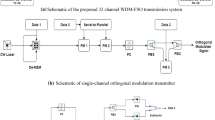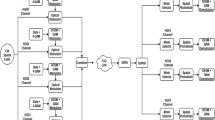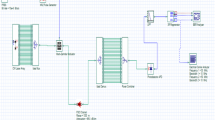Abstract
In this paper, we report the modeling and simulative investigation of a free space optics (FSO) transmission system using non-return to zero/differential quadrature phase shift keying/polarization shift keying 3-D orthogonal modulation scheme in which three independent 40 Gb/s data streams are transmitted simultaneously using different signal parameters over the same channel to improve the spectral efficiency of the link. The proposed system demonstrates a successful transmission of 120 Gb/s information over an FSO link range of 25 km with an acceptable bit-error rate (\(\sim 10^{ - 9}\)) under clear weather conditions. The performance of the proposed link is also analyzed under the effect of atmospheric turbulence. Further, we compare the performance of the proposed system with previously reported works in the literature and the results demonstrate that the proposed 3-D orthogonal modulation scheme based FSO transmission system performs better in terms of spectral efficiency, information capacity and maximum achievable link distance.
Similar content being viewed by others
Avoid common mistakes on your manuscript.
1 Introduction
The availability of ample amount of underexploited and unlicensed spectrum has made free space optics (FSO) a promising technology for future wireless networks. Other merits of FSO links include high-speed links, immunity to electromagnetic interference, low beam divergence, quick and easy deployment, lightweight equipment, last mile access, low power consumption, cost-effectiveness, and secure information transmission (Singh and Kumar 2013; Badar and Jha 2017). But the performance of FSO links is dependent on certain external factors including signal absorption, multipath fading, scattering, scintillation, atmospheric turbulence and most importantly signal attenuation offered due to different weather conditions which degrade the quality of the received signal and limit the link reach (Fadhil et al. 2013). Further, modulation format plays a critical role in determining the performance of FSO links. The work in Hammed et al. (2014) and Nadeem et al. (2017) reports the performance comparison of FSO transmission system under the influence of atmospheric turbulence using different intensity modulation schemes and at different data transmission rates. The results presented show that non-return to zero (NRZ) modulation performs the best under the influence of atmospheric turbulence and high data transmission rate. The performance analysis of subcarrier intensity modulation binary phase shift keying (SIM-BPSK) based FSO link over 3 km link range under the influence of atmospheric turbulence and pointing errors is discussed in Al-Nahhal et al. (2017). The modeling and performance investigation of a 10 Gb/s differential quadrature phase shift keying (DQPSK) based FSO link over 800 m FSO link range has been demonstrated in Shao et al. (2016). The work in Prabu et al. (2018) reports the impact of atmospheric turbulence and pointing errors on polarization shift keying (PolSK) based FSO transmission system over generalized atmospheric turbulence model.
In order to enhance the information capacity in FSO links, various multiplexing techniques have been explored by many researchers in previous works. The work in Badar et al. (2018) reports the modeling and simulative investigation of 8λ × 10 Gb/s wavelength division multiplexing (WDM) based FSO link incorporating differential phase shift keying (DPSK) under the influence of different weather conditions. The performance of high-speed mode division multiplexing (MDM) based FSO link incorporating NRZ scheme over different atmospheric weather conditions has been demonstrated in Chaudhary and Amphawan (2018). The work in Sarangal et al. (2017) reports the modeling and performance investigation of 100 Gb/s optical code division multiple access (OCDMA) based FSO link incorporating MDM of Laguerre Gaussian (LG) modes under the influence of atmospheric turbulence. The performance investigation of orthogonal frequency division multiplexing (OFDM) based FSO link under the influence of atmospheric turbulence has been discussed in Kumar and Teixeira (2016). The work in Kaur et al. (2019) reports the modeling and simulative investigation of a novel hybrid polarization division multiplexing (PDM)–OFDM based FSO link incorporating coherent detection under the influence of atmospheric turbulence.
With the advancements in optical communication technology, researchers are more focused on improving the spectral efficiency and channel capacity of the links to realize long-haul transmission system. Orthogonal modulation scheme is considered as a viable technology to realize large-capacity, long-reach, and high-speed optical transmission links. In recent literature, various orthogonal modulation schemes such as DPSK/dark return to zero (DPSK/DRZ), DPSK/NRZ, amplitude shift keying/frequency shift keying (ASK/FSK), and ASK/DPSK have been proposed to improve the spectral efficiency and achieve high-speed optical links (Chow et al. 2006; Zhang et al. 2008; Ohm and Speidel 2003; Wang et al. 2003). These modulation formats enhance the information capacity and provide multi-bit-per-symbol transmission links (Dai et al. 2011).
In this work, in order to enhance the information capacity and improve spectral efficiency, we propose a 3-D orthogonal modulation format combining non-return to zero/differential quadrature phase shift keying/polarization shift keying (NRZ/DQPSK/PolSK) based FSO transmission system, which according to the best of author’s knowledge has not been reported in the earlier literature. Further, the performance of the proposed link is also investigated under different fog conditions. The rest of the paper is organized as Sect. 2 presents the proposed system design and simulation parameters followed by results in Sect. 3 and the final conclusion in Sect. 4.
2 System design
Figure 1a demonstrates the transmitter section of the proposed system which has been designed using Optisystem simulation software.
40 Gb/s binary information (Data 1) is generated using a pseudo-random bit sequence generator which is line encoded using a NRZ pulse generator and then modulated using a dual electrode-Mach–Zehnder modulator (De-MZM) with 30 dB extinction ratio operating in push–pull state and a 0 dBm continuous wave (CW) laser beam. At this point, an NRZ modulated signal is generated.
The NRZ signal is then launched towards a phase modulator. 40 Gb/s binary Data 2 is divided into two parallel streams using a serial-to-parallel converter. One data stream is used to drive first phase modulator (PM1) and the other data stream is used to drive second phase modulator (PM2). PM1 modulates the phase of the optical signal to \(\pi ,\) whereas PM2 adds a \({\raise0.7ex\hbox{$\pi $} \!\mathord{\left/ {\vphantom {\pi 2}}\right.\kern-0pt} \!\lower0.7ex\hbox{$2$}}\) phase shift to the signal. Two phase modulators are used to modulate the phase of the carrier signal to generate a DQPSK signal. Here, an NRZ/DQPSK modulated signal is generated.
This signal is then directed at 45° phase angle using a polarization controller (PC) towards a Polarization beam splitter (PBS) for PolSK modulation. The PC at 45° phase angle is used to maintain orthogonality between NRZ/DQPSK signals and PolSK signal. A third phase modulator (PM3) is placed between horizontal ports of the PBS and polarization beam combiner (PBC) to modulate binary Data 3 at 40 Gb/s, whereas their vertical ports are directly connected. At the output of PBC, the proposed NRZ/DQPSK/PolSK modulated signal is generated which is transmitted in the free space using the transmitter lens. The link equation can be expressed as (Kaur and Chaudhary 2016):
where \(d_{R}\) represents receiver aperture diameter, \(d_{T}\) represents transmitter aperture diameter, \(\theta\) represents beam divergence angle, Z is the link range, and \(\sigma\) represents the atmospheric attenuation value. The simulation parameters used in this paper are tabulated in Table 1.
The receiver section of the proposed system is shown in Fig. 1b. At the receiver terminal, the orthogonal modulated signal contains the NRZ/DQPSK/PolSK modulated signals. The receiver section includes three distinct paths to recover the transmitted signals independently.
A 3-dB coupler at the front end of the receiver terminal splits the input power to NRZ receiver section, which consists of a PIN photodiode and a low pass filter (LPF) for the direct detection of the amplitude modulated signal. Here, we do not need to adjust the state of polarization (SOP) of the signal since NRZ signal is modulated at the transmitter section without changing the SOP. Although, the received signal also contains DQPSK and PolSK signals, the receiver section here uses only a PIN photodiode which will retrieve the information encoded in the amplitude (intensity) variations of the optical carrier signal. A LPF is used to remove any high-frequency noise present in the signal. Here, the NRZ encoded data 1 is recovered successfully.
By properly adjusting the SOP of the received signal, we can distinguish between DQPSK and PolSK signal. At the receiver section, a PC at 45° (same as that of transmitter section) is aligned for detecting PolSK signal. A polarization beam splitter (PBS) splits the PolSK signal and a balanced detector is used to detect the PolSK signal. Here, the PolSK encoded data 3 is recovered independently.
For detecting DQPSK signal, a linear polarizer is used which is aligned to block the PolSK modulated signal. The DQPSK signal is recovered using two Mach–Zehnder interferometers (MZI) with 2 s delay and a balanced detector. Here, the DQPSK encoded data 2 is recovered independently.
The atmospheric attenuation due to different weather conditions can be determined using the following equation (Ghassemlooy and Popoola 2010):
where V (km) represents range of visibility, \(\lambda \;({\text{nm}})\) is the wavelength and p is the distribution coefficient of scattering and can be determined by Kim model as (Kim et al. 2006):
The atmospheric attenuation values under different weather conditions are presented in Table 2.
3 Results and discussions
In this section, we discuss the results of the simulative investigation of the proposed system. Figure 2 reports the quality factor (Q factor) and BER of the received signal as a function of increasing link range under clear weather conditions using the proposed system. From the results, it can be seen that as the FSO link range increases, the quality of the received signal degrades which limits the maximum link reach. The Q factor of the received signal is computed as 25.96 dB, 16.26 dB, and 10.71 dB for DQPSK modulation scheme; 25.46 dB, 15.96 dB, and 10.56 dB for PolSK modulation scheme; and 19.53 dB, 10.40 dB, and 5.96 dB for NRZ modulation scheme at a FSO link range of 14 km, 19.5 km, and 25 km respectively. Similarly, BER of the received signal is computed as 5.31e−149, 8.01e−060, and 4.09e−027 for DQPSK modulation scheme; 1.89e−143, 9.61e−058, and 1.78e−026 for PolSK modulation scheme; and 2.88e−085, 1.10e−025, and 1.19e−009 for NRZ modulation scheme at a FSO link range of 14 km, 19.5 km, and 25 km respectively. The results demonstrate a successful transmission of 120 Gb/s information over FSO link range of 25 km under clear weather conditions with acceptable performance (Q factor ~ 6 dB and BER < 10−9) using the proposed FSO transmission system incorporating 3-D orthogonal modulation scheme. Also, from the results, it can be seen that for the same link distance, DQPSK and PolSK performs better than NRZ modulation scheme. This is because in NRZ modulation, the information is carried in the form of intensity variations of carrier signal which is more affected by atmospheric turbulence while DQPSK involves transmitting information in the form of phase variations and PolSK encodes digital information in state of polarization (SOP) by assigning logical 0 and 1 to orthogonal SOP and thus providing more robustness to atmospheric turbulence (Prabu et al. 2018; Badar et al. 2018). Figure 3 reports the eye diagram of the received signal for different modulation schemes at a link range of 25 km under clear weather conditions. The wide eye opening with acceptable Q factor demonstrates a successful recovery of the information signal at the receiver terminal.
In this work, we also investigate the performance of the proposed system under the influence of different fog conditions. Figures 4 and 5 report the Q factor and BER of the received signal respectively as a function of increasing FSO link range under different fog conditions. Table 3 tabulates the maximum supported link range with acceptable performance under different fog conditions using the proposed link. From the results, it can be seen that as the atmospheric attenuation increases from light fog to heavy fog conditions, the maximum supported link range decreases. The maximum supported link range under light fog conditions is reported as 2400 m which reduces to 2000 m under moderate fog and 1600 m under heavy fog conditions using the proposed link.
In this work, we also compare the performance of the proposed 3-D orthogonal modulation scheme based FSO transmission system with previously reported works in the literature in Table 4. The results presented in Table 4 demonstrate that the proposed system demonstrates a better spectral efficiency, information carrying capacity, and maximum link reach as compared to the previously reported works.
4 Conclusion
In this paper, a high-speed spectral-efficient FSO transmission system has been modeled and investigated using NRZ/DQPSK/PolSK 3-D orthogonal modulation scheme under different weather conditions. Using the proposed system, 120 Gb/s information is successfully transmitted over 25 km FSO link range under clear weather conditions with acceptable BER (\(< 10^{ - 9}\)) and Q factor (~ 6 dB). The performance of the proposed system is also investigated under different fog conditions and the maximum supported link range under light fog is reported as 2.4 km which reduces to 2 km under moderate fog and 1.6 km under heavy fog conditions. The proposed 3-D orthogonal modulation scheme based FSO transmission system can be deployed in next-generation wireless networks to realize long-reach, high-speed, and bandwidth efficient information transmission links. In future works, the information carrying capacity of the proposed system can further be enhanced by incorporating various multiplexing schemes like WDM, PDM, and MDM.
References
Al-Nahhal, M., Ismail, T., Selmy, H., Elmesalawy, M.M.: BPSK based SIM-FSO communication system with SIMO over log-normal atmospheric turbulence with pointing errors. In: 2017 19th International Conference on Transparent Optical Networks (ICTON), Girona, pp. 1–4 (2017)
Badar, N., Jha, R.K.: Performance comparison of various modulation schemes over free space optical (FSO) link employing Gamma–Gamma fading model. Opt. Quantum Electron. 49, 192–201 (2017)
Badar, N., Jha, R., Towfeeq, I.: Performance analysis of 80 (8 × 10) Gbps RZ-DPSK based WDM-FSO system under combined effects of various weather conditions and atmospheric turbulence induced fading employing Gamma–Gamma fading model. Opt. Quantum Electron. 50, 1–11 (2018)
Chaudhary, S., Amphawan, A.: Solid core PCF-based mode selector for MDM-Ro-FSO transmission systems. Photonic Netw. Commun. 36(2), 263–271 (2018)
Chow, C.-W., Kwok, C.H., Tsang, H.K., Lin, C.: Optical label switching of DRZ/DPSK orthogonal signal generated by photonic-crystal fiber. Opt. Lett. 31, 2535–2537 (2006). https://doi.org/10.1364/ol.31.002535
Dai, B., Gao, Z., Wang, X., Kataoka, N., Wada, N.: A novel optical orthogonal modulation format based on differential phase-shift keying and code-shift keying. IEEE Photonics Technol. Lett. 23(17), 1210–1212 (2011)
Fadhil, H.A., et al.: Optimization of free space optics parameters: an optimum solution for bad weather conditions. Optik Int. J. Light Electron Opt. 124(19), 3969–3973 (2013)
Ghassemlooy, Z., Popoola, W.O.: Terrestrial free space optical communications. In: Fares, S.A., Adachi, F. (eds.) Mobile and Wireless Communication Network Layer and Circuit Level Design. InTech, Rijeka (2010)
Hammed, N., Mehmood, T., Qasim, A.: Parametric investigation of different modulation techniques on free space optical systems. In: Proc. IEEE 12th International Conference on Frontiers on Information Technology, pp. 11–15 (2014)
Kaur, D., Chaudhary, S.: 4 × 10 GBPS cost effective hybrid OADM-MDM short haul interconnects. Microw. Opt. Technol. Lett. 58, 1613–1617 (2016). https://doi.org/10.1002/mop.29869
Kaur, G., Srivastava, D., Singh, P., Parasher, Y.: Development of a novel hybrid PDM/OFDM technique for FSO system and its performance analysis. Opt. Laser Technol. 109, 256–262 (2019)
Kim, I., Mcarthur, B., Korevaar, E.: Comparison of laser beam propagation at 785 and 1550 nm in fog and haze for optical wireless communications. In: Proc. of SPIE Optical Wireless Communication, vol. 6303 (2006)
Kumar, N., Teixeira, A.L.J.: 10 Gbit/s OFDM based FSO communication system using M-QAM modulation with enhanced detection. Opt. Quantum Electron. 48, 9–15 (2016)
Nadeem, L., Saadullah Qazi, M., Hassam, A.: Performance of FSO links using CSRZ, RZ, and NRZ and effects of atmospheric turbulence. J. Opt. Commun. 39(2), 191–197 (2017)
Ohm, M., Speidel, J.: Quaternary optical ASK-DPSK and receivers with direct detection. IEEE Photonics Technol. Lett. 15(1), 159–161 (2003)
Prabu, K., Gupta, S., Jaiswal, S.: Impact of pointing errors and turbulence effects on POLSK and coherent OWC-based FSO system over generalized turbulence channel model. Photonic Netw Commun 36, 96–105 (2018)
Sarangal, H., Singh, A., Malhotra, J., Chaudhary, S.: A cost effective 100Gbps hybrid MDM-OCDMA-FSO transmission system under atmospheric turbulences. Opt. Quantum Electron. 49, 184–193 (2017)
Shao, Y., Chen, F., Chen, L., Shen, S., Wang, A., Luo, Y., Tan, Z.: DP-DQPSK optical access system integrated with fiber and free-space downlink for high spectral efficiency application. Opt. Photonics J. 6, 108–113 (2016)
Singh, J., Kumar, N.: Performance analysis of different modulation format on free space optical communication system. Optik Int. J. Light Electron Opt. 124(20), 4651–4654 (2013)
Wang, X., He, Z., Liu, H., et al.: Improved optical coding method for orthogonal ASK/DPSK modulation format. Front. Optoelectron. China 1, 14–19 (2008)
Zhang, Y., Deng, N., Chan, C.K., Chen, L.K.: A multicast WDM-PON architecture using DPSK/NRZ orthogonal modulation. IEEE Photonics Technol. Lett. 20(17), 1479–1481 (2008)
Author information
Authors and Affiliations
Corresponding author
Additional information
Publisher's Note
Springer Nature remains neutral with regard to jurisdictional claims in published maps and institutional affiliations.
Rights and permissions
About this article
Cite this article
Singh, M., Malhotra, J. Performance investigation of high-speed FSO transmission system under the influence of different atmospheric conditions incorporating 3-D orthogonal modulation scheme. Opt Quant Electron 51, 285 (2019). https://doi.org/10.1007/s11082-019-1998-2
Received:
Accepted:
Published:
DOI: https://doi.org/10.1007/s11082-019-1998-2









